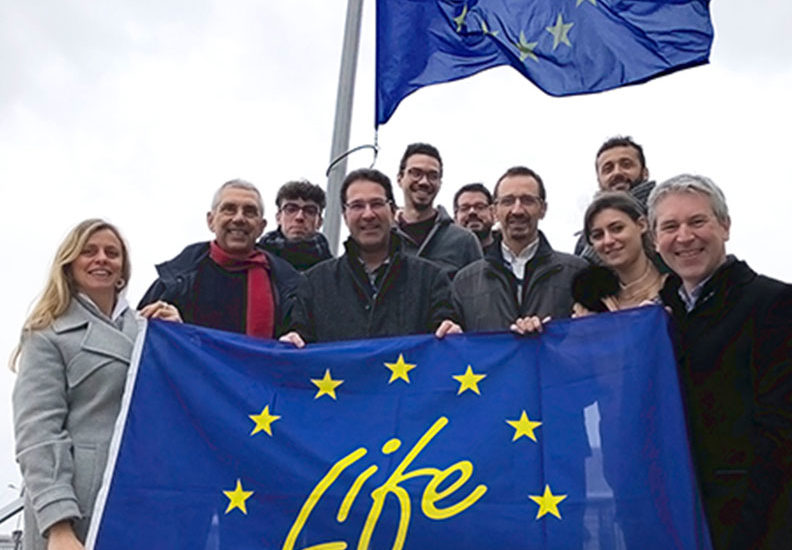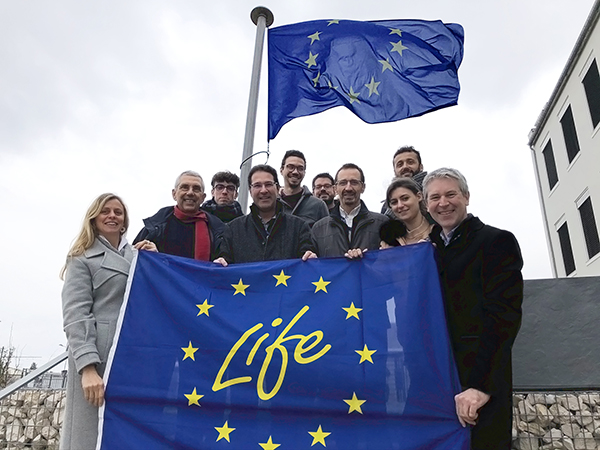The EU contributes to the development of SF6-free 420 kV switchgear
- 8 October 2020
- Posted by: Lfgrd_admn_ge_2020
- Categories: CLIMATE CHANGE, G3, SF6-FREE SOLUTIONS, Uncategorized

EU’s Life Program funding recognizes g3 Gas as a sustainable alternative to SF6 in high voltage equipment
On September 26th, 2019, GE announced its g3 product deployment roadmap. A major milestone in this roadmap is the development of a 420 kV gas-insulated switchgear. GE submitted this development project to the EU’s LIFE Program, the EU’s funding instrument dedicated to actions to protect the environment and the climate, and has received approval for a two-year funding grant. This program, which GE has named “LifeGRID”, recognizes g3 gas as a valuable and sustainable alternative technology to using SF6 in high voltage equipment.

The LIFE Program was created by the EU in 1992. It is divided in two sub-programs, one for the environment and one for the climate change (representing 25% of the envelope).
The program’s 2018 call for tender encourages applications for demonstration, pilot or best practice projects showing the use of low Global Warming Potential (GWP) alternatives to SF6, which is exactly what GE’s g3-LifeGRID project will demonstrate.

GE’s LifeGRID project has received funding from the LIFE Program of the European Union
EU’s LIFE Program’s funding accelerates GE’s development of world’s first 420 kV g3 circuit-breaker, thus SF6-free.
The ambition of GE’s LifeGRID program is to help reduce greenhouse gas emissions from high-voltage substations via the development of a SF6-free switchgear. The area of focus for LifeGRID is for climate change mitigation through the use of GE’s g3 gas mixture as an SF6-alternative gas in circuit breakers. “Because 420 kV is the highest voltage level used in most European countries, a proven g3–insulated 420 kV circuit breaker will demonstrate that g3 technology can be applied to all other standard high-voltage levels and deployed throughout the other gas-insulated substation components,” explained Yannick Kieffel, GE’s Materials and Eco-Design Team Leader, and LifeGRID Project Leader.

Yannick Kieffel, LifeGRID project Leader and the LifeGRID team
LifeGRID project perfectly matches with the regulatory targets and ambitions at the EU level and beyond:
- Carbon Neutrality ambition of the EU by 2050
- Paris Agreement: keeping a global temperature rise this century below 2 degrees Celsius above pre-industrial levels and to pursue efforts to limit the temperature increase further to 1.5 degrees Celsius
- LIFE Program is the only EU funding program which specifically targets fluorinated greenhouse gases (F-gases)
- LifeGRID falls directly under the fluorinated-gases regulation (EU) No 517/2014, which aims at cutting the EU’s F-gas emission by two-thirds by 2030 compared with 2014 levels
As part of the LifeGRID project, a transnational cooperation with the University of Brno in the Czech Republic and the Leibniz Institute for Plasma Science and Technology, INP- Greifswald in Germany has been developed. The aim of this collaborative work is the creation of a g3 gas properties database that will allow GE’s R&D experts to speed up the development of this 420 kV gas insulated substation (GIS) and accelerate the deployment of g3 technology throughout all the other products at this voltage level and underneath. CEA, a leading French Research Centre, will also take part in the circuit breaker development and European Transmission System Operators (TSOs) will help test and implement the final product.
Finally, LifeGRID could also help assess the use of g3 as alternative gas to SF6 in other industries such as the particle accelerator industry, the nuclear fusion industry, the magnesium industry and the electrostatic loudspeaker industry.
GE Renewable Energy’s Grid Solutions’ R&D experts have already begun their investigations to define the best 420 kV g3-insulated switchgear concept. This is the beginning of a fascinating journey toward decarbonization of the 420 kV transmission network, the backbone of Europe’s electrical grid.
